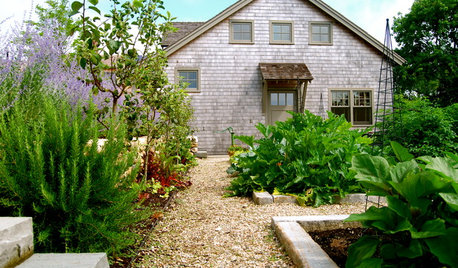looking for advice on black soldier maggots in Compost
albrechtnatural
14 years ago
Featured Answer
Sort by:Oldest
Comments (30)
spaghetina
14 years agolast modified: 9 years agorj_hythloday
14 years agolast modified: 9 years agoRelated Discussions
Do Black Soldier Fly Larvae need a way out of my composting bin?
Comments (10)Ok ok ok. Perspective and knowledge are power. Yes they need a way out, young larvae burrow down for moisture food and safety, adults burrow up looking for dry and light escape. Don't worry tho, some will make it, and breed 100s more! Yes BSFL are voracious eaters but we don't rely on food waste for mass in the compost, it becomes dense nutrient after being eat by larvae and insects. BACK are SUPER BENEFICIAL if you do not like house flies. The larvae and adult BSFs don't eat the flus themselves however the flies eggs are a SUPER TASTY TREAT to the BSFL and I have seen a SERIOUS reduction in the house fly population on my farm. Once you have them in the compost they pretty much take over. No BSFL do not stink, it is anaerobic bacteria breeding that stinks. Brew up some lactobacillus acidophilus and put that liquid and the cheese into the pit. You will notice the larvae look clean after an hour, the cheese curds are a SUPER nutrient rich tasty treat and your compost will have a sweet and sour smell. Check out http://theunconventionalfarmer.com/recipes/bim/ for some of the most valuable information I have ever read! HAPPY GARDENING!!!...See MoreCan I use maggot infested compost for...
Comments (18)I can't believe I'm thinking this, far less posting it, but... Not all flies spread disease, and there's at least one sort of non-pestiferous fly some folks do want in their compost, under certain conditions. (Not relevant to the OP, which referenced _tiny_ flies, but still.) Despite my personal squeamishness about the things, BSFL are welcome in any batch of new compost I've set aside for feeding to my composting worm colony; their leavings make the worms happy. And that is mixed hot compost, though I clock average temperatures more in the warm zone, 100+ but rarely as high as 140. I assume the BSFL would leave a pile that hot, but if it sustained those temperatures, I'd likely opt not to feed that batch to the worms anyway. Stirring doesn't bother BSFL all that much once they're larger than hatchlings, and I'm told their presence helps deter pest flies, though I can't say I've done any testing to verify that! DSF http://bokashislope.blogspot.com making compost one bucket at a time...See MoreMaggots in Compost Bin
Comments (27)Yeah my compost bin can be BONE DRY and when I add leftovers and table scraps and pieces of veggies and fruit I get BSFL on the items. NOT in all areas of my bin but in the EXACT items. An example would be melon rinds or avocados. The BSFL live only in certain foods and NOT in the rest of the bin as my bin is never over wet. They eat and poop and fly away. So for a person to say that they are a result of an over wet or over damp bin is only HALF correct. BSFL are a result of what is IN your bin also. Like I said, your bin can be bone dry but as soon as you add some veggies or fruits with a bit of moisture your bound to get some kind of bugs. As long as your bin is not over ridden and FULL of bugs or soaking wet it is OK and Its all part of the process. Just keep your bin semi dry and a little moist and you should have no problems cutting down on the "bug" population. If its too wet you can open it up and air it out for a day or two. Personally I find a small population of BSFL are beneficial to the bin....See Moremaggots in compost?
Comments (2)I doubt that they're anything to worry about. They're most likely a larvae of a regular type of fly, or the larvae of the Black Soldier Fly. Both of these lay eggs on or near decomposing garbage, they eat their way through their larval period, and then they hatch out into whatever fly they are. This link shows the lifecycle of the common housefly: http://science.howstuffworks.com/environmental/life/zoology/insects-arachnids/housefly4.htm This is the nuisance fly that makes a nuisance of itself in your home, patio and around your picnics. This link shows the larval and adult stages of the black soldier fly (BSF): http://www.esrint.com/pages/bioconversion.html You will notice that as the larvae of the BSF get larger, they get flatter and turn brown. If you have chickens, ducks, the larger pet birds, fish or some reptiles, they find these larvae delicious and nutritious at all stages, as they are high in protein, calcium and other nutrients. These flies hate being indoors, so you aren't likely to find them much in your house or around your food, as they prefer decomposing organic materials. By the time the compost has finished, it's safe for either veggies or ornamentals, no matter which fly it is. Sue...See MoreLloyd
14 years agolast modified: 9 years agospaghetina
14 years agolast modified: 9 years ago11otis
14 years agolast modified: 9 years agospaghetina
14 years agolast modified: 9 years agopetalpatsy
14 years agolast modified: 9 years agoKimmsr
14 years agolast modified: 9 years agoalbrechtnatural
14 years agolast modified: 9 years agojoepyeweed
14 years agolast modified: 9 years agobpgreen
14 years agolast modified: 9 years agoFrankie_in_zone_7
14 years agolast modified: 9 years agorj_hythloday
14 years agolast modified: 9 years agoKimmsr
14 years agolast modified: 9 years agoliz1231
13 years agolast modified: 9 years agorandy_coyote
13 years agolast modified: 9 years agopjames
13 years agolast modified: 9 years agoberryman135678
13 years agolast modified: 9 years agoberryman135678
13 years agolast modified: 9 years agoannpat
13 years agolast modified: 9 years agodsfoxx
13 years agolast modified: 9 years agorandy_coyote
13 years agolast modified: 9 years agoKimmsr
13 years agolast modified: 9 years agoannpat
13 years agolast modified: 9 years agoliz1231
13 years agolast modified: 9 years agobsf_jerry
13 years agolast modified: 9 years agoKimmsr
13 years agolast modified: 9 years agodsfoxx
13 years agolast modified: 9 years agodsfoxx
13 years agolast modified: 9 years ago
Related Stories

GARDENING GUIDESGet on a Composting Kick (Hello, Free Fertilizer!)
Quit shelling out for pricey substitutes that aren’t even as good. Here’s how to give your soil the best while lightening your trash load
Full Story
FARM YOUR YARDAdvice on Canyon Farming From L.A.'s Vegetable Whisperer
See how a screened garden house and raised beds help an edible garden in a Los Angeles canyon thrive
Full Story
NATIVE PLANTS5 Ways to Keep Your Native Plant Garden Looking Good All Year
It’s all about planning ahead, using sustainable practices and accepting plants as living organisms
Full Story
WINTER GARDENINGPruning Secrets for Exquisite Roses
Encourage gorgeous blooms year after year with this time-tested advice on how to prune your rosebush in winter for health and shape
Full Story
HOUSEKEEPINGHow to Clean Your Range and Oven
Experts serve up advice on caring for these kitchen appliances, which work extra hard during the holidays
Full Story
MOST POPULARMeet a Lawn Alternative That Works Wonders
Carex can replace turfgrass in any spot, is low maintenance and adjusts easily. Add its good looks and you’ve got a ground cover winner
Full Story
HOUSEPLANTS10 Top Plants to Grow Indoors
Brighten a room and clean the air with a houseplant that cascades artfully, stretches toward the ceiling or looks great on a wall
Full Story
KITCHEN DESIGN10 Upgrades for a Touch of Kitchen Elegance
Give your kitchen a more refined look by changing just a detail or two
Full Story
GARDENING GUIDESThe Simple Secret to Gardening Success
Learn the kinds of soil and a DIY type test to make sure you’re putting the right plant in the right place
Full Story
EDIBLE GARDENSSummer Crops: How to Grow Tomatoes
Plant tomato seedlings in spring for one of the best tastes of summer, fresh from your backyard
Full Story


petalpatsy